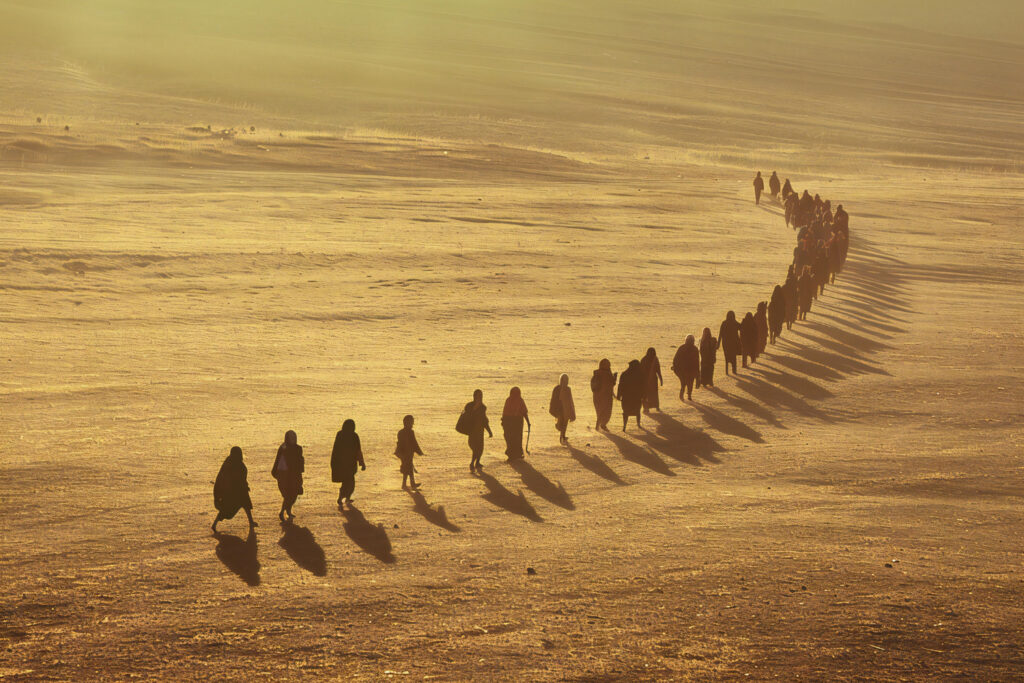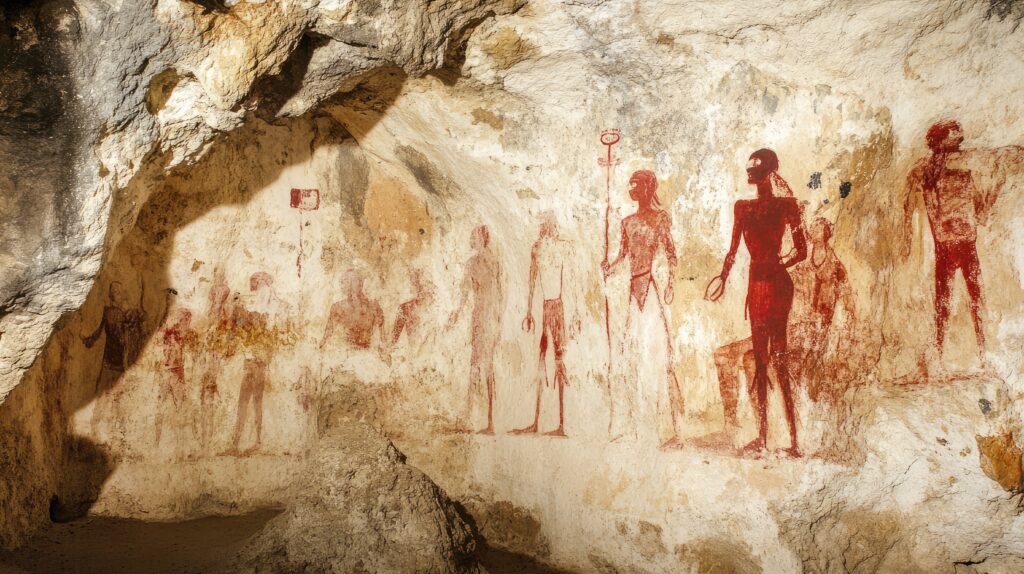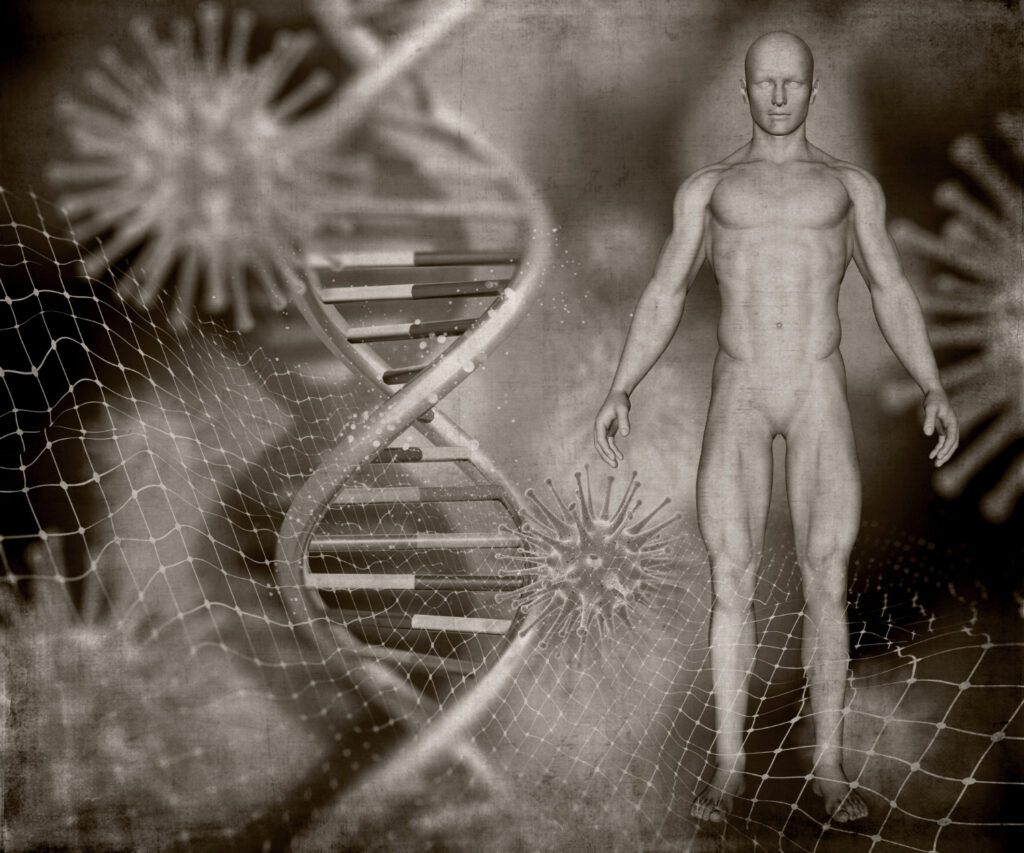By Mariana Meneses
For decades, we told ourselves a simple story: modern humans emerged from Africa, spread across the globe, and gradually replaced their archaic cousins—Neanderthals, Denisovans, and others lost to time. It was a clean, directional narrative—migration as progress, contact as absorption, extinction as inevitability. But scientific discoveries are dismantling that clarity.
Across continents and time periods, ancient DNA is exposing a more fragmented, irregular, and often one-sided web of human interactions. Ghost lineages — populations that left no archaeological trace yet persist in the genetic record — together with groups that lived side by side without blending, and technologies that uncover what the eye once missed: all of it points to a new understanding. Increasingly, it appears that our evolutionary path was never a straight line, but a mosaic of divergence, collision, and incomplete connections.
In 2024, archaeologist Ludovic Slimak and colleagues presented the discovery of a late Neanderthal named “Thorin,” whose remarkably preserved remains were found at Grotte Mandrin in southeastern France—a cave previously identified as one of the earliest sites of Homo sapiens’ arrival in Europe around 54,000 years ago.
Thorin’s genome analysis revealed a striking genetic isolation of approximately 50,000 years, challenging the longstanding idea that Europe’s late Neanderthals formed a single, interconnected population. Surprisingly, Thorin was genetically closer to a Neanderthal from Gibraltar named “Nana,” located over 1,700 kilometers away, than to Neanderthals from nearby regions. This suggests that certain Neanderthal lineages were spread across vast distances yet maintained limited or no genetic interactions with neighbouring groups, fundamentally reshaping our understanding of Neanderthal population dynamics.
Writing in The Conversation France, Slimak reflects on what these findings imply beyond the genetic data. Thorin’s group, he suggests, may have inhabited the world in ways profoundly different from our own, marked by cultural and social boundaries that resisted contact, even with neighboring Neanderthals and early Homo sapiens. Archaeological evidence supports this, as Thorin’s group used a distinctive set of stone tools known as the Post-Neronian II (PNII) tradition, setting them apart from other Neanderthal populations in nearby regions.
Genetically, their long isolation aligns with the emerging picture of ghost lineages. For Slimak, such patterns point to a deeply fragmented Neanderthal world, where small, scattered groups lived in proximity but rarely, if ever, interacted.
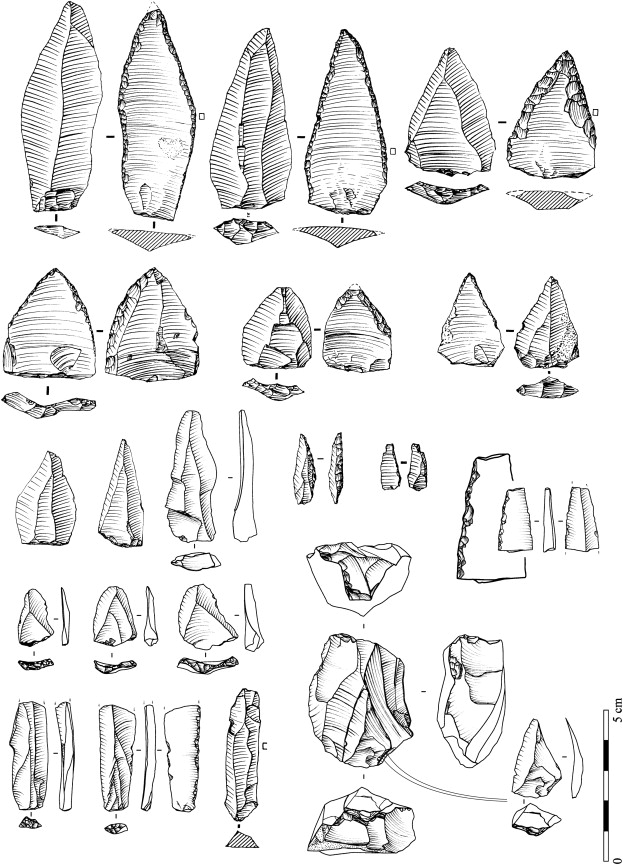
Illustration of stone tools from Mediterranean France, attributed to a Neanderthal tradition known as Post-Neronian II (PNII), marked by flake-based toolmaking techniques typical of the Middle Paleolithic period. Credit: Slimak (2008).
In January, The Quantum Record spotlighted Slimak’s research as part of a broader shift in how technology is reshaping our understanding of human ancestry. Framing Thorin’s genetic isolation and the absence of reciprocal gene flow as markers of social immobility, the article emphasized that Neanderthals may have lacked the migratory flexibility needed to survive environmental shocks. With their genes present in modern humans but not the reverse, Neanderthals appear as a lineage deeply embedded in place—vulnerable not because of inferiority, but because of social and biological insularity.
The piece casts this pattern as emblematic of a larger theme in human evolution: that survival often hinged less on strength than on adaptability, and that diversity—in both genes and movement—was a crucial asset in an unpredictable world.
In a 2024 Live Science interview, Slimak offered a provocative reinterpretation of the encounters between Neanderthals and Homo sapiens, framing them not as moments of harmonious integration but as failed attempts at alliance.
Drawing on genetic and anthropological insights, Slimak highlights a stark asymmetry in the genetic record: while early modern humans carry traces of Neanderthal DNA, no Neanderthal fossils show evidence of admixture from Homo sapiens. This pattern, he argues, mirrors traditional anthropological structures like patrilocality, in which women are exchanged between groups to forge social bonds. In this case, it seems that Neanderthal women may have entered Homo sapiens communities, but the reverse did not occur—suggesting deep cultural or symbolic boundaries. Furthermore, Slimak posits that biological incompatibilities, such as sterility in male offspring, may have prevented these unions from producing lasting hybrid populations.
Rather than viewing interbreeding as evidence of mutual belonging, he interprets it as a sign of repeated but ultimately unsuccessful attempts to merge distinct human worlds.
Slimak draws attention to a subtler yet powerful contrast between the two species. While Homo sapiens were characterized by uniformity and efficiency—producing toolkits with almost industrial precision—Neanderthals displayed an extraordinary degree of individuality and creative variation. Each of their tools appears uniquely crafted, adapted to the shape, texture, and color of the raw material, suggesting a relationship with the environment grounded in improvisation and responsiveness. In Slimak’s view, the meeting between these two species was not a clash between primitive and advanced, but between two different modes of being: the superefficient and the supercreative.
The disappearance of Neanderthals, then, may not have been the result of conquest or intent, but of the quiet dominance of efficiency over diversity.
What happened after Neanderthals disappeared?
If Neanderthal extinction tells a story of cultural isolation and missed alliances, the aftermath of their disappearance opens another chapter—one not of genetic silence, but of accelerated complexity. In the millennia that followed, new human populations surged across the Eurasian landscape, and ancient DNA reveals that this was no single wave of expansion or simple replacement. It was, instead, a turbulent patchwork of migrations, frontiers, and fusions that redefined the genetic and cultural makeup of the continent.
In one of the most sweeping reconstructions of post-glacial population history in western Eurasia, Allentoft and colleagues (2024) sequenced 317 ancient genomes—mostly from the Mesolithic and Neolithic—and combined them with over 1,300 published datasets to model population histories across western Eurasia. What emerges is not a smooth arc of ancestry, but a sharply divided continent.
For thousands of years after the last Ice Age, a genetic frontier stretched from the Black Sea to the Baltic. To the west, the arrival of Anatolian farmers triggered profound demographic turnover, often replacing local hunter-gatherers entirely. To the east, however, local forager societies remained genetically and culturally stable, resisting the pull of agriculture. The divide persisted for millennia, only collapsing with the dramatic westward expansion of Yamnaya pastoralists, whose ancestry—long elusive—was here traced to a previously upsampled population from the Middle Don region that had already blended Eastern Hunter-Gatherer and Caucasus ancestry.
This group, the study suggests, seeded one of the most consequential population movements in prehistory: the steppe migrations that reshaped the genetic fabric of Europe.
The genomic record reveals multiple, regionally distinct episodes of contact, replacement, and resilience. In western Europe, early farmers occasionally admixed with local hunter-gatherers before being themselves transformed by incoming groups with steppe ancestry, often channeled through the Corded Ware Culture (CWC)—a cultural and genetic hybrid born of Yamnaya-related groups and the Globular Amphora Culture.
In Scandinavia and Siberia, hunter-gatherer lineages persisted far longer, with genetic signals tracing post-glacial expansions from southern Europe, the Caucasus, and northeast Asia. Even at the eastern edge of the study area, populations retained deep local ancestry until around 4,000 years ago, when waves of migration—carrying horses, wheeled vehicles, millet, and metallurgical knowledge—began to integrate the forest-steppe world into broader continental dynamics. What we see is not the triumph of one population over another, but a slow dissolution of ancient boundaries.
And the story doesn’t end in Europe.
As genomic technologies expand their reach, similar patterns of layered migration, cultural endurance, and regional divergence are emerging in other parts of the world. Nowhere is this clearer than in East Asia, where a new generation of studies is uncovering equally intricate population histories—revealing not only the movement of people, but also the formation of long-lasting cultural frontiers.

Painted Pottery Pot Early Dawenkou Culture (c. 4,400—3,600 BCE) Excavated from Wangyin Site, Yanzhou, Shandong. Capital Museum, Beijing. Credit: Fo Guang Shan.
In a 2025 study published in Nature Communications, Juncen Liu and colleagues reconstruct 6,000 years of population history in coastal northern East Asia by sequencing the genomes of 85 individuals from the ShanDong region of China. This area—long known for its dynamic cultural transitions—turns out to have been a genetic bridge between inland East Asian populations and the islands of the Japanese archipelago. The study identifies two major waves of gene flow from inland Yellow River populations into ShanDong: the first during the DaWenKou culture (6000–4600 BP), coinciding with the rise of farming and early cultural complexity; the second during the early dynastic period (after 3500 BP), likely linked to intensified trade and political conflict in the region.
BP (Before Present): A time scale used mainly in archaeology, geology, and related sciences to date events relative to a fixed “present”—set at January 1, 1950. This standard reflects the start of widespread radiocarbon dating and avoids confusion caused by changes in atmospheric carbon after nuclear testing. BP is often used for radiocarbon-dated events but can apply more broadly to ancient timelines (Wikipedia).
Despite these pulses, or bursts, of inland ancestry, the authors find remarkable within-region continuity during the LongShan period (4600–4000 BP), suggesting a cultural convergence that did not rely on renewed migration. Throughout, ShanDong populations remained genetically distinct from their inland neighbors and showed earlier-than-expected contact with both northern and southern East Asian groups.
Most strikingly, the study uncovers a genetic trail connecting ShanDong coastal populations to post-Yayoi communities in the Ryukyu Islands, suggesting that northern coastal East Asian ancestry—not previously identified in ancient samples—played a critical role in shaping Japanese genetic diversity.
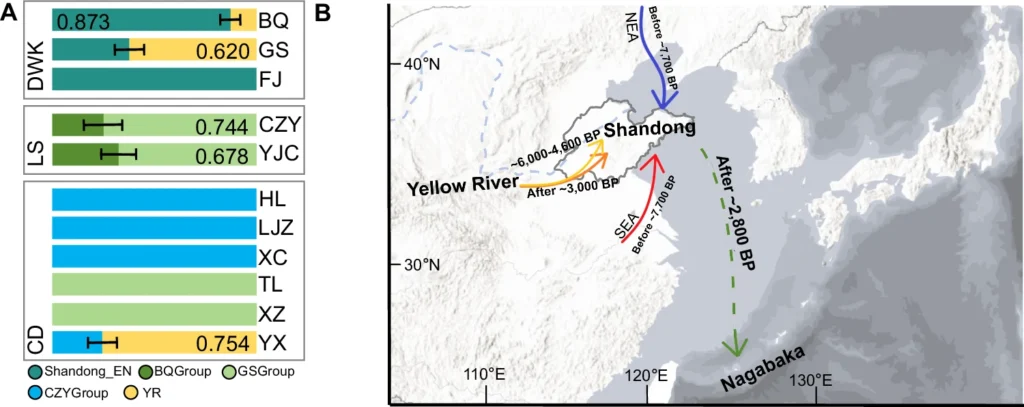
Gene flow related to the ShanDong populations. Credit: Liu et al (2025).
Using admixture modeling, the authors show that historical populations in Ryukyu can best be explained by a three-way ancestry: Jōmon hunter-gatherers, inland northern East Asians (analogous to Yayoi migrants), and a coastal component linked to ShanDong populations from the LongShan and early dynastic periods. The genetic influence from ShanDong appears to have entered Ryukyu after ~2800 BP, consistent with historical records of contact during the Sui Dynasty. Notably, this influence was not detected in contemporaneous populations from mainland Japan (Hondo), reinforcing the idea that Japan’s genetic history is regionally differentiated and more complex than previously thought.
Together, these findings recast the eastern Asian seaboard not as a periphery, but as a corridor of interaction—shaping genomes, languages, and cultures across the East China Sea.
Zooming back in: from population-scale reconstructions to the fine-grained traces of individual lives
The search for human origins also depends on the smallest clues: a sliver of bone, a fragment of tooth, a tool flake lost to time. While genome sequencing is transforming our understanding of ancient peoples across continents, new technologies are equally revolutionizing how we investigate what’s left behind in a single cave. One such advance is unfolding at Grotte Mandrin—the very site where Thorin was found.
In a 2025 study published in Archaeological and Anthropological Sciences, Oldfield, Buckley, Slimak, and colleagues introduced AutoZooMS, an automated robotic protocol designed to revolutionize how researchers extract species-level information from highly fragmented archaeological bone. Focusing on the Zone Thorin of Grotte Mandrin—a site already pivotal for understanding late Neanderthal presence in Europe—the team applied this method to over 1,600 morphologically unidentifiable bone fragments from layer B2 (~42,000–44,000 years ago), a cultural horizon associated with the Post-Neronian II tradition.
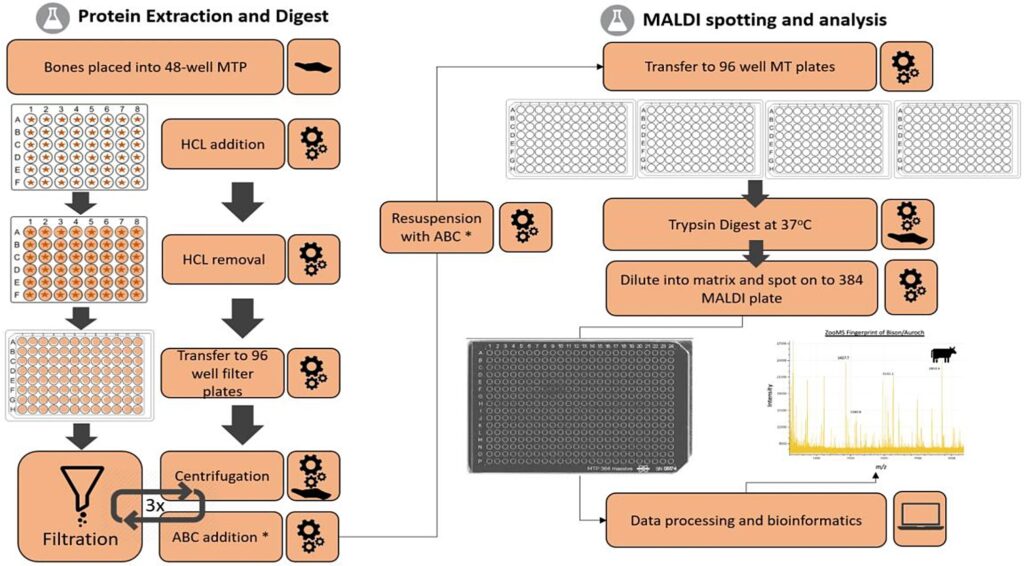
“AutoZooMS workflow. Hand symbol represents manual intervention, e.g., removing plates from machine and placing in centrifuge or incubator.” Credit: Oldfield et al (2025).
Compared to previous low- and high-throughput collagen fingerprinting techniques, AutoZooMS achieved a 60% species identification success rate, substantially improving both speed and scale. Notably, the method identified a far greater taxonomic diversity —that is, a wider range of species — than earlier efforts, including evidence of mammoth, woolly rhinoceros, bear, and additional hominin remains likely belonging to Neanderthals, insights that were previously lost in the mass of undifferentiated bone.
But the significance of AutoZooMS extends beyond technical refinement. By scaling up identification, the method challenges assumptions shaped by traditional sampling limits. For instance, earlier morphological and molecular analyses of Grotte Mandrin’s faunal assemblage (i.e., the collection of animal remains, like bones, teeth, etc., found together in an archaeological site) failed to detect species like Mammuthus, not because they weren’t present, but because they were too rare to surface in small samples. AutoZooMS renders such hidden presences visible, reshaping reconstructions of prehistoric ecologies and subsistence strategies.
This is especially relevant in regions like Zone Thorin, where human and faunal remains are densely intermingled.
The technique also holds ethical promise: by maximizing data retrieval from anonymous fragments, researchers may avoid destructive analysis of precious, identifiable specimens like teeth or tools. As Slimak’s broader work emphasizes the complexity of Neanderthal life at Mandrin, AutoZooMS offers a practical counterpart—a way of seeing what’s otherwise invisible, amplifying our capacity to read meaning from the debris of deep time.
And once more, we widen the lens.
If AutoZooMS lets us recover lost lives in a single cave, other technologies are redrawing ancient maps across oceans. In the Americas, recent genetic findings are reshaping assumptions about how people first arrived—not by a single path, but through a web of possible connections, including across the Pacific.
In a 2025 study published in the journal Genes, Antonio Arnaiz-Villena and colleagues examine the genetic profiles of three relatively isolated Indigenous groups in northern Colombia—the Chimila, Wiwa, and Wayúu—using high-resolution HLA (Human Leukocyte Antigen) sequencing. Their goal was to assess how these groups relate to other Amerindian populations and to test hypotheses about trans-Pacific contact.
The authors found that these groups share highly frequent and sometimes unique HLA haplotypes, which are also present in Oceanian and Southeast Asian populations, but not in the genetically closer North Asian or Siberian groups. This pattern challenges the classic Beringian migration model, which assumes a single route of entry into the Americas from northeast Asia. Instead, the data support the possibility of prehistoric trans-Pacific gene flow, either as a complementary migration stream or as a result of contact between coastal populations across the Pacific. These Colombian populations cluster genetically with other Amerindians, forming a distinct clade apart from Asian, Na-Dene, and European groups, while the urban Barranquillan population—used as a comparison group—shows clear Mediterranean-European admixture.
Beyond its genetic findings, the study contributes to the growing body of evidence undermining the “Clovis-first” narrative of American settlement. The presence of Oceanian-linked alleles (different versions of a gene that reflect inherited genetic variation) in coastal Amerindian populations, combined with archaeological parallels—such as similarities between Easter Island moai and Andean statues, and the pre-Columbian spread of crops like the sweet potato—strengthens the case for early maritime contact.
The study also illustrates how cultural and linguistic continuity in groups like the Wiwa and Chimila—who have preserved matrilineal clans, traditional rituals, and sacred geographies—coexists with long-term genetic isolation, creating populations that are internally homogeneous yet historically connected to distant peoples. In this sense, the research offers a provocative alternative to linear models of migration, suggesting a networked prehistory in which oceans were not barriers but corridors for selective, asymmetric exchange.
Taken together, the discoveries outlined in this article—and many others emerging around the world—remind us that human history was never linear, uniform, or inevitable. It was shaped by isolation and contact, by resilience and rupture, by migrations that fizzled and others that flourished.
From the fragmented lives recovered in a French cave to genetic echoes linking Colombia and Oceania, ancient DNA reveals a world where difference was the norm and convergence was rare, often accidental. But more than just correcting the past, this knowledge casts a subtle light on the present.
As Slimak warns, danger may lie in our ability to expand, replicate, and overwhelm through scale. To reckon with this legacy, we must first unlearn the myth of the straight line—and begin to see ourselves as part of a tangled, unfinished story, whose future depends, as ever, on how we choose to move through the world.
Craving more information? Check out these recommended TQR articles:
- Digital Sovereignty: Cutting Dependence on Dominant Tech Companies
- Does Time Flow in Two Directions? Science Explores the Possibility—and its Stunning Implications
- Do We Live Inside a Black Hole? New Evidence Could Redefine Distance and Time
- What’s Slowing the Expansion of the Universe? New Technologies Probing Dark Energy May Hold the Answer
- The Corruption of Four-Dimensional Humanity with Two-Dimensional Technology

